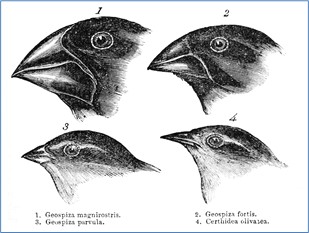No products in the cart.
Return To ShopDarwin’s Finches: Evidence for Evolution or Epigenetics?
Natural history museums everywhere feature the work and ideas of Charles Darwin, whom many would call the father of evolutionary theory. So—what’s Darwin’s best shot? I mean, what is the number one “proof” of evolution that he’s offered the world? Well, if you look in museums and textbooks, that’s quite obvious—it’s Darwin’s finches.

Just how do these finches support the idea of evolution? Well, when Darwin visited the Galápagos Islands in the 1830s, he observed that the sizes and shapes of the finch beaks tended to vary island by island. He believed that this was evidence of “evolution” by nature selecting the birds with favorable adaptations—like their beak types—to survive and reproduce because they were better suited for gathering the different types of food sources available on the various islands.
But think about this for a minute—what Darwin actually observed was that the finch beak sizes and shapes differed based on where the finches lived. So—were these birds just adapting to their environment and food sources within their own, God-prescribed genetic programming, or were they “evolving”?
Darwin believed that adding millions of years to such minor changes in creatures could eventually lead to the evolution of new “kinds” of creatures. And this belief is just that—a belief based on faith and speculation. In fact, in four to five thousand years of recorded history, no one has ever seen this happen—one kind turning into another kind. All we see is exactly what’s prescribed in Genesis: animals produce after their own “kinds.”
Sure, we see plenty of variety, like over 300 different dog breeds that are all inter-fertile within the dog “kind,” and the same with over 300 breeds of horses. We see this variety because God pre-programmed the mechanisms in our genes to turn on and off certain instructions based on our environment and diet—that’s all. It’s not evolution leading from one kind to another—it’s adaptation within kinds—a big difference.
In fact, the Biblical case gets even stronger when it’s lined up with modern, observational science. Recent studies have shown that Darwin’s finches never actually did support his evolutionary ideas.
The most recent breakthrough was published in 2017 in the journal titled Evolutionary Biology. This study tracked over 1,000 finches that lived in either rural or urban environments to find out how and why their beak sizes and shapes can differ based on where they lived. The studies revealed that significant differences in beak depth and width between urban and rural populations of finches were caused by “epigenetic mechanisms,” such as DNA methylation. Methyl “tags” change the way a gene is expressed without any changes to its DNA sequence. This highly regulated mechanism enables rapid adaptation of finch beaks and other traits to fit their new environments, even within a couple of generations.[ii]
So, rather than Darwin’s evolutionary ideas of “natural selection”[iii] explaining the changes in finches, the changes are actually evidence for an intelligent “Master Engineer” who designed creatures with built-in adaptive mechanisms that turn on and off certain features as they continuously experience environmental changes, enabling them to “fill the Earth” as their Creator commanded. Creatures are not passive modeling clay molded by their environment as Darwin taught. We now know that they are active, problem-solving entities that can tackle a myriad of challenges and fill a remarkable range of environments, which showcases the engineering genius of their Creator. So, it’s actually the continuous, environmental tracking systems that are already built into the bird that’s making the changes and adaptations, not the environment causing the bird to “evolve” in some way. It looks like the Master Designer knew what he was doing when He created animals after their kinds and gave them the commission to multiply and fill the Earth.
[i] Darwin, 1845. Journal of researches into the natural history and geology of the countries visited during the voyage of H.M.S. Beagle round the world, under the Command of Capt. Fitz Roy, R.N. 2d edition.
[ii] McNew, S. M. et al. “Epigenetic variation between urban and rural populations of Darwin’s finches.” BMC Evolutionary Biology 17 (2017): 183.
[iii] Creation ministries hold varying positions on the extent to which “Natural Selection” plays a part in biological diversity. There is agreement, however, that Natural Selection is not a mechanism that drives vertical evolution as claimed by evolutionists. See: Purdom, Georgia & Jeanson, Nathaniel T. “Understanding Natural Selection. Clarifying the Confusion.” Posted May 7, 2018). Answers in Genesis. https://answersingenesis.org/natural-selection/understanding-natural-selection/. Accessed September 22, 2020.









